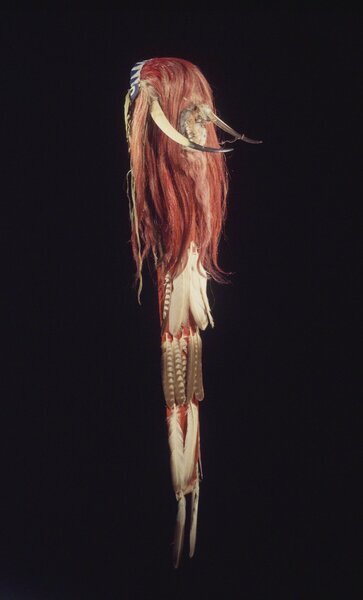Split Horn Headdress Item Number: 11.694.9050 from the Brooklyn Museum

Description
The front of the headdress has a beaded headband in blue and white. From under the headband, trailing down the back is dyed red horse hair. Two long horns (beef horns) are on either side. A roach of bird skin and feathers is fastened to center of horsehair trailer. Four bands of dyed feathers are attached to a red wool trailer faced with cotton fabric that hangs down the back of the headdress. According to Sean Standing Bear 10/24/2000) the small concentric beaded circles on either side of the headdress are 'eyeballs.'
Credit Line
Museum Expedition 1911, Museum Collection Fund
Label
Shunkahmolah, a leader of the Black Bear clan priesthood, showed this headdress to the ethnologist Francis La Flesche and Brooklyn Museum curator Stewart Culin when they visited him in 1911. According to Osage consultants, the headdress was used in ritual preparations for the hunt.
The Osage cosmos is composed of an invisible creative force, called Wakonta, that is ever-changing within an ordered cosmos constructed with four major, interwoven divisions: sky, earth, day, and night. The sky is associated with north, the left side, and the male gender. Earth is allied with the south, the right side, and the female gender. Day is linked to the east, the sun, life, birth, the male gender, and the color red. Night is connected to the west, the moon, destruction, the female gender, and the color black. Regalia worn by the Osage people often symbolically reflect the complex elements of their cosmos.
The kingfisher attached to the back of the headdress symbolically unites the Osage Sky and Earth people, since the bird flies in the sky and hunts in the water. The bird also unites the male (sky) and female (earth) forming the left and right side of the Osage universe. The northern harrier and red-tailed hawk feathers attached to the trailer are symbolic of the sun or life and give the hunter the power to move quickly and effectively.
Item History
- Made between 1875 and 1925
What
- Name
- Split Horn Headdress
- Identification Number
- 11.694.9050
- Type of Item
- headdress, split and horn
- Material
- horn, horse hair, rooster feather, hawk birdskin, hide, glass bead, fur, silk, wool, cotton and sinew
- Measurements
- “49 x 9 in. (124.5 x 22.9 cm)” ?
Who
- Culture
- Osage
Where
- Holding Institution
- Brooklyn Museum
When
- Creation Date
- between 1875 and 1925
Other
- Classification
- Clothing